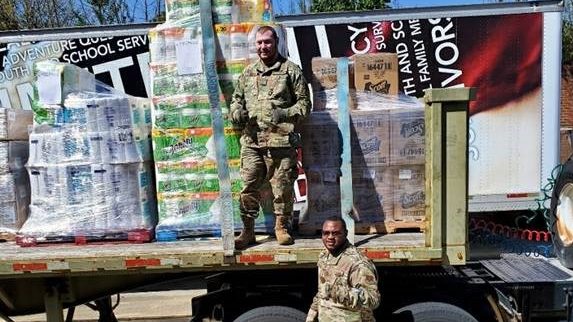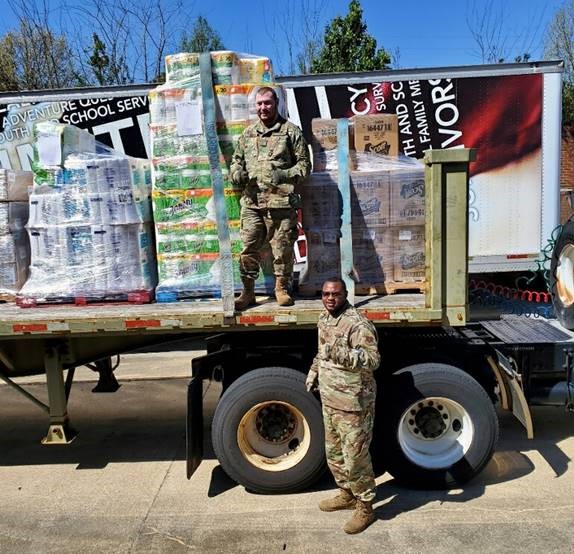From Suppliers to Shoppers: How the Exchange Keeps Products Moving During COVID-19 Crises


PAR’s Ed Madden, Lakisha Taylor and Colbie Lake work from their homes to keep the Exchange’s supply chain moving as smoothly as possible during COVID-19.
Getting products from suppliers to shoppers is always complex, but the COVID-19 pandemic has highlighted the importance of the supply chain, especially for the mission-essential Exchange.
The biggest challenge facing the Exchange’s merchandising team is vendor supply. The Exchange’s suppliers serve many companies, and they all want the same items: hand sanitizers, masks, toilet paper and cleaning products.
“It’s all hands on deck to find product,” said Director of Planning, Allocation and Replenishment (PAR) Shirley Strano. “We’re talking about getting hundreds of thousands of units to all corners of the world quickly.”
On the Logistics side of the supply chain, transportation is moving, but some carriers are facing delays because companies everywhere are all trying to ship product to meet increasing demand, said Exchange Senior Supply Chain Strategist Genny Garcia.
“It’s really about adjusting priorities and organizing the chaos so that everyone’s on the same page,” said Garcia, who serves as a bridge between the merchandising and logistics teams. “Plus, there are lots of little factors that can slow you down if you’re not prepared. For example, things like hand sanitizer and bleach are considered hazardous materials, so that requires extra paperwork when air-shipping.”
Because of the Exchange’s detailed inventory system and strong communication with regions and stores, the PAR team saw the early signs of the impending crisis and began working to keep product moving.
MD Replenishment Manager Ed Madden recalls getting a text from his boss on a Sunday morning in late February asking him to pull some numbers on what was in-stock at Pacific Region stores.

Troops at Joint Base Langley-Eustis show their gratitude for products being delivered. The Langley-Eustis Exchange team got a command request and MD/LG/DC teams worked to expedite the order and get it to them within four days.
“I was flabbergasted when I pulled the report,” Madden said. “We were wiped out of several supplies in PAC—toilet paper, paper towels, cleaning supplies—in a matter of days. That was a real light-bulb moment about how expansive this was going to be.”
Though the Exchange has supported many disasters such as hurricanes and tornadoes, past crises have affected a geographically limited area for a defined time period. COVID-19 is a global issue with an uncertain timeline.
While the processes throughout the supply chain are mostly the same, the sense of urgency is “off the charts,” Madden said.
“I’ve never seen anything like the pace we’re at now in my 30-plus years in retail. People and companies are buying certain items at 10 times the level they were just a couple of months ago,” Madden said. “We’re getting calls that we need to air-freight toilet paper to Kwajalein because they’re out right now.”
The PAR team is the central hub for buyers, regions and command to contact for assistance. They’ve even set up an emergency portal for the regions to submit requests for products.
“It’s not as simple as placing an order,” Strano said. “A lot of analysis has to go into how much product goes where. We have some very large installations, but need to make sure our shoppers at smaller stores are getting what they need too.”
And it’s not just the hand sanitizer and paper products that are in high demand. With many people working from home and kids learning remotely, the need for computers and accessories has grown rapidly. Business clothes sales are down, but loungewear demand is up.
When command at certain installations requested that barbershops be closed, those installation Exchanges saw a run on hair clippers.
“When we were air-shipping cleaning supplies around the globe, I never would have thought about the need for hair clippers,” Madden said. “The pandemic is causing ripples through a lot of product categories, not just the obvious ones we think of—hand sanitizer and masks, etc. It’s a challenge to stay ahead of the demand.”
Amid all the stress, logistics and details of the supply chain, the Exchange team keeps its eyes on the end goal: taking care of military communities.
“You see associates across the entire enterprise all stepping up to do the best thing for our shoppers,” Garcia said.
With so many elements and factors affecting the supply chain, the Exchange’s success in continuing to serve the military comes down to associates.
“It starts with the people. The Exchange team doesn’t quit,” Madden said. “Last week, an associate spent an extra three hours after already working a full day to process an urgent order. That’s the mind-set: Whatever needs to be done, we will do for our Warfighters and their families. It’s the mission that sets the Exchange apart.”

